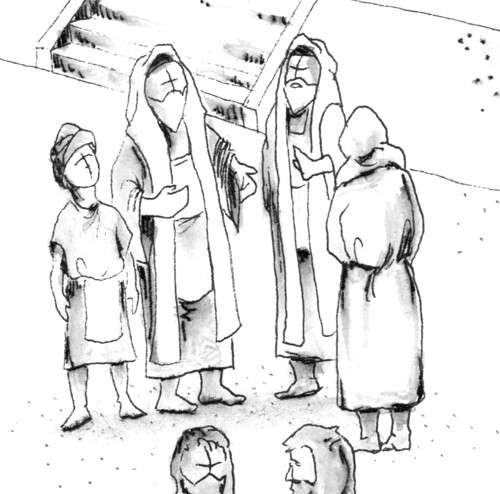« Ignatius Under Arrest | Main | Sadducees »
June 18, 2005
Pharisees
The prehistory of the Pharisaic movement — and its outcome — are less clear than the characteristics of the movement itself. Even some of the main points of Pharisaism, however, involve significant scholarly debate.
Certain aspects of Pharisaism have been accepted by almost all scholars. It was a lay movement of religious renewal that emphasized heightened attention to the Torah. The Pharisees’ interest in purity laws strikes contemporary readers as particularly noteworthy, though that may derive more from the difference between Pharisaic purity and conventional contemporary purity. Pharisees emphasized a way of observance that accommodated a common citizen’s circumstances more flexibly than would a strict literal adherence to the Torah, though that still entailed a more scrupulous attention to details than many ordinary less-committed people would find congenial. To oversimplify: in matters of observance, Pharisees taught that everyone ought to observe the next higher degree of purity than Torah requires of her or him; thus, a (non-priestly) male Pharisee ought to maintain the purity expected of a priest. Thus people would be protected against transgression, inasmuch as their errors or transgressions would contravene not the strictly-applicable portion of the Torah, but the heightened expectations (our hypothetical Pharisee might fail to maintain priestly purity, but would still be likely to have maintained the purity required of everyday men).
Pharisees taught that the Torah comprises only part of God’s law; The remaining part comees to expression in traditions handed down over generations of religious-ethical reasoning. The Law recorded in Scripture thus constitutes the “written Torah,” as distinct from the “oral Torah.” Certain doctrinal and ethical points go unaddressed in the written Torah, but the Pharisees draw on resources from the oral tradition (and exercise the adaptable character of such a tradition) to address concerns that came to the fore after the completion of the Torah. For one instance, the firm Pharisaic belief in a resurrection of the dead illustrates the authority that they ascribed to a point that other Torah-observant groups regarded as non-biblical.
Once, scholars inferred that the Pharisees were a direct offshoot of the rebellious hasidim who instigated the revolt that led to the Hasmonean kingdom. More recently, that explanation has seemed to rest on too thin a chain of evidence; hypotheses regarding the origins of the Pharisees locate them everywhere from among the scribes associated with Nehemiah’s return, to Herodian religious reformers.
Likewise the Pharisees were for a long time assumed to have mutated into the rabbis. Some undoubtedly rabbinic texts, however, seem to take a dim view of the Pharisees, so a direct Pharisee > rabbi connection seems less probable.
Finally, although the gospels present the Pharisees as “hypocrites” and conspiratorial adversaries of Jesus, that picture should be interpreted in light of the early, active rivalry between Jesus’ followers and the Pharisees; external evidence does not support the New Testament’s hostile characterization of the Pharisees.
(Varieties of Judaism) Previous ⇐ Main ⇒ Next (Sadducees)
External Links:
The Jewish Encyclopedia (1901-06), “Pharisees”
Ecole Initiative article on “Pharisees”
Steve Mason, “Current Scholarship on the Pharisees”
Jonthan D. Brumberg-Kraus, “Were the Pharisees a Conversionist Sect/”
Posted by AKMA at June 18, 2005 06:23 PM
